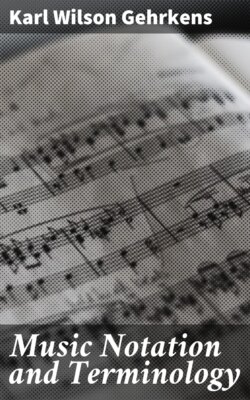Читать книгу Music Notation and Terminology - Karl Wilson Gehrkens - Страница 5
На сайте Литреса книга снята с продажи.
Some Principles of Correct Notation
ОглавлениеTable of Contents
1. The note (from nota—Latin—a mark or sign) consists of either one, two, or three parts, () these being referred to respectively as head, stem, and hook. The hook is often called tail or cross-stroke. The stem appears on the right side of the head when turned up, but on the left side when turned down.[1] The hook is always on the right side.[2]
In writing music with pen the head and hook are best made with a heavy pressure on the pen point, but in writing at the board they are most easily made by using a piece of chalk about an inch long, turned on its side.
2. When only one part (or voice) is written on the staff, the following rules for turning stems apply: (1) If the note-head is below the third line, the stem must turn up. (2) If the note-head is above the third line the stem must turn down. (3) If the note-head is on the third line the stem is turned either up or down with due regard to the symmetrical appearance of the measure in which the note occurs. The following examples will illustrate these points.
[Listen]
3. When two parts are written on the same staff, the stems of the upper part all turn up, and those of the lower part turn down, in order that the parts may be clearly distinguished. (Fig. 2.) But in music for piano and other instruments on which complete chords can be sounded by one performer and also in simple, four-part vocal music in which all voices have approximately the same rhythm, several notes often have one stem in common as in Fig. 3.
[Listen]
[Listen]
4. Notes of small denomination (eighths and smaller) are often written in groups of two or more, all stems in the group being then connected by one cross-stroke. In such a case all the stems must of course be turned the same way, the direction being determined by the position of the majority of note-heads in the group. Notes thus stroked may be of the same or of different denomination. See Fig. 4.
[Listen]
In vocal music notes are never thus stroked when a syllable is given to each note. (See p. 19, Sec. 55, C.)
5. Rests, like notes, are best made with a heavy pen stroke or by using a piece of chalk on its side. (See note under Sec. 1.) The double-whole rest, whole rest, and half rest occupy the third space unless for the sake of clearness in writing two parts on the same staff they are written higher or lower. The rests of smaller denomination may be placed at any point on the staff, the hooks being always placed on the spaces. The hook of the eighth rest is usually placed on the third space. Rests are sometimes dotted, but are never tied.
6. The G clef should be begun at the second line rather than below the staff. Experiments have shown clearly that beginners learn to make it most easily in this way, and the process may be further simplified by dividing it into two parts, thus, . The descending stroke crosses the ascending curve at or near the fourth line. The circular part of the curve occupies approximately the first and second spaces.
7. The F clef is made either thus, , or thus, the dots being placed one on either side of the fourth line of the staff, which is the particular point that the clef marks. The C clef has also two forms, and .
8. The sharp is made with two light vertical strokes, and two heavy slanting ones, the slant of the latter being upward from left to right, ♯. The sharp should never be made thus, #.
The double sharp is made either thus or *, the first form being at present the more common.
9. The flat is best made by a down stroke retraced part way up, the curve being made without lifting pen from paper. The double flat consists of two flats,[3] ♭♭. The natural or cancel is made in two strokes, down-right and right-down, thus ♮.
10. The tie usually connects the heads of notes, thus .
11. The dot after a note always appears on a space, whether the note-head is on a line or space. (See Fig. 5.) In the case of a dot after a note on a line, the dot usually appears on the space above that line if the next note is higher in position and on the space below it if the following note is lower.
[Listen]
Note.—Correct notation must be made a habit rather than a theory, and in order to form the habit of writing correctly, drill is necessary. This may perhaps be best secured by asking students to write (at the board or on ruled paper) from verbal dictation, thus: Teacher says,
"Key of B♭, three-quarter measure: First measure, DO a quarter note, RE a quarter, and MI a quarter. Second measure, SOL a quarter, LA a quarter, and SOL a quarter. Third measure, LA, TI, DO, RE, MI, eighths, stroked in pairs. Fourth measure, high DO a dotted half." Pupils respond by writing the exercise dictated, after which mistakes in the turning of stems, etc., are corrected. The pitch names may be dictated instead of the syllables if desired, and still further practice may be provided by asking that the exercise be transposed to other keys.
